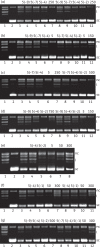QnrS1 structure-activity relationships
- PMID: 24729602
- PMCID: PMC4100707
- DOI: 10.1093/jac/dku102
QnrS1 structure-activity relationships
Abstract
Objectives: Loop B is important for low-level quinolone resistance conferred by Qnr proteins. The role of individual amino acids within QnrS1 loop B in quinolone resistance and gyrase protection was assessed.
Methods: qnrS1 and 11 qnrS1 alleles with site-directed Ala mutations in loop B were expressed in Escherichia coli BL21(DE3) and proteins were purified by affinity chromatography. Ciprofloxacin MICs were determined with and without IPTG. Gyrase DNA supercoiling was measured with and without ciprofloxacin IC50 and with various concentrations of QnrS1 proteins.
Results: Wild-type QnrS1 and QnrS1 with Asn-110→Ala and Arg-111→Ala substitutions increased the ciprofloxacin MIC 12-fold in BL21(DE3), although QnrS1 with Gln-107→Ala replacement increased it 2-fold more than wild-type did. However, QnrS1 with Ala substitutions at His-106, Val-108, Ser-109, Met-112, Tyr-113, Phe-114, Cys-115 and Ser-116 increased ciprofloxacin MIC 1.4- to 8-fold less than wild-type QnrS1. Induction by 10-1000 μM IPTG increased ciprofloxacin MICs for all mutants, reaching values similar to those for wild-type. Purified wild-type and mutated proteins differed in protection of gyrase from ciprofloxacin action. Wild-type QnrS1 produced complete protection of gyrase supercoiling from ciprofloxacin (1.8 μM) action at 0.05 nM and half protection at 0.5 pM, whereas QnrS1 with Ala replacements that conferred the least increase in ciprofloxacin MICs also required the highest QnrS1 concentrations for protection.
Conclusions: Key individual residues in QnrS1 loop B affect ciprofloxacin resistance and gyrase protection from ciprofloxacin action, supporting the concept that loop B is key for interaction with gyrase necessary for quinolone resistance.
Keywords: QnrS; pentapeptide repeat proteins; quinolone resistance.
© The Author 2014. Published by Oxford University Press on behalf of the British Society for Antimicrobial Chemotherapy. All rights reserved. For Permissions, please e-mail: journals.permissions@oup.com.
Figures


References
Publication types
MeSH terms
Substances
Grants and funding
LinkOut - more resources
Full Text Sources
Other Literature Sources
Medical
Miscellaneous

